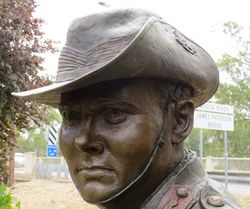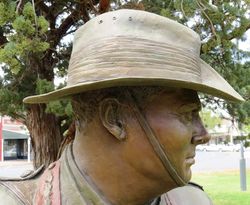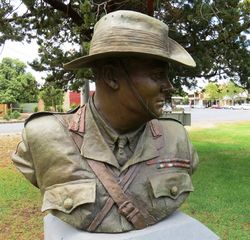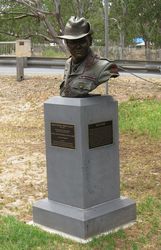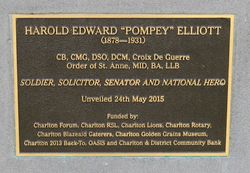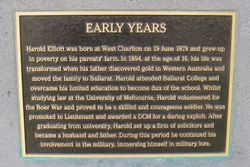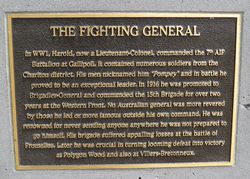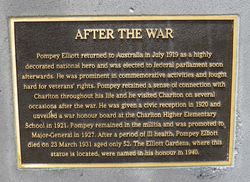
Major General Harold "Pompey" ElliottPrint Page 
The sculpture commemorates the renowned officer of the South African (Boer) War and World War One, Major General H. E. Elliott, who was born and raised at West Charlton.
Harold Edward "Pompey" Elliott CB, CMG, DSO, DCM, VD (19 June 1878 – 23 March 1931) was a senior officer in the Australian Army during World War One. He also served as a Senator in the Australian parliament.
Location
| Address: | Calder Highway (High Street), Elliott Gardens, Charlton, 3525 |
|---|---|
| State: | VIC |
| Area: | AUS |
| GPS Coordinates: | Lat: -36.267594 Long: 143.348717 Note: GPS Coordinates are approximate. |
Details
| Monument Type: | Sculpture |
|---|---|
| Monument Theme: | People |
| Sub-Theme: | Military |
Dedication
| Actual Monument Dedication Date: | Sunday 24th May, 2015 |
|---|
Harold Edward "Pompey" Elliott
(1878 - 1931)
CB, CMG, DSO, DCM, Croix De Guerre
Order of St. Anne, MID, BA, LLB
Soldier, solicitor, Senator and national hero
Unveiled 24th May 2015
Funded by :
Charlton Forum, Charlton RSL, Charlton Lions, Charlton Rotary,
Charlton Blazeaid Caterers, Charlton Golden Grains Museum,
Charlton 2013 Back-To, OASIS and Charlton & District Community Bank
Early Years
Harold Elliott was born at West Charlton on 19 June 1878 and grew up in poverty on his parents` farm. In 1894, at the age of 16, his life was transformed when his father discovered gold in Western Australia and moved the family to Ballarat. Harold attended Ballarat College and overcame his limited education to become dux of the school. Whilst studying law at the University of Melbourne, Harold volunteered for the Boer War and proved to be a skilled and courageous soldier. He was promoted to Lieutenant and awarded a DCM for a daring exploit. After graduating from university, Harold set up a firm of solicitors and became a husband and father. During this period he continued his involvement in the military, immersing himself in military lore.
The Fighting General
In WW1, Harold, now a Lieutentant-Colonel, commanded the 7th AIF Battalion at Gallipoli. It contained numerous soldiers from the Charlton District. His men nicknamed him "Pompey" and in battle he proved to be an exceptional leader. In 1916 he was promoted to Brigadier-General and commanded the 15th Brigade for over two years at the Western Front. No Australian general was more revered by those he led or more famous outside his own command. He was renowned for never sending anyone anywhere he was not prepared to go himself. His brigade suffered appalling losses at the battle of Fromelles. Later he was crucial in turning looming defeat into victory at Polygon Wood and also at Villers-Bretonneux.
After The War
Pompey Elliott returned to Australia in July 1919 as a highly decorated national hero and was elected to Federal Parliament soon afterwards. He was prominent in commemorative activities and fought hard for veterans` rights. Pompey retained a sense of connection with Charlton throughout his life and he visited Charlton on several occasionS after the war. He was given a civic reception in 1920 and unveiled a war honour board at the Charlton Higher Elementary School in 1921. Pompey remained in the militia and was promoted to Major-General in 1927. After a period of ill health, Pompey Elliott died on 23 March 1931 aged only 52. The Elliott Gardens, where this statue is located, were named in his honour in 1940.


